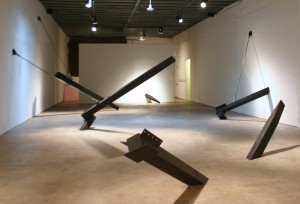« Reviews
Ralph Provisero / Celluloid Drag: Some Space Between Film and Architecture

Installation view of Ralph Provisero exhibition at Celluloid Drag: Some Spaces Between Film and Architecture. Courtesy Dorsch Gallery.
Dorsch Gallery
March 14 - April 18
By Carlos Suárez De Jesús
For his sweeping installation at the Dorsch Gallery, Miami-based sculptor Ralph Provisero salvaged the steel beams from another Miami gallery to create a work exuding both power and grace.
The dynamic installation, titled Traiettorie Architettoniche (or Everybody’s got their own arrows), gave the impression the artist had pierced the building’s inner walls with mammoth missiles.
The work was commissioned as part of “Celluloid Drag: Some Space Between Film and Architecture” curated by Terri C. Smith, which also featured a suite of 50 small abstract paintings by Todd McDaniel and a film by Gordon Matta-Clark.
Provisero’s introduction of recycled beams and scavenged architectural elements into Dorsch’s interior forced the spectator into experiencing the gallery in an almost cinematic way.
As one walked around and under Provisero’s stark projectile-shaped forms, poking through walls or crashing into and then erupting out of the concrete floors, they conjured the image of a scarred urban battlefield or of a construction-site implosion.
The artist’s use of tie rods to suspend the massive beams in place added to the precarious nature of the installation and collared the viewer into re-imagining one’s physical relation to the space and work.
As one wended his way under Provisero’s looming structures, they also evoked thoughts of the Sword of Damocles teetering over one’s head. The blunted tips and what appeared to be angular fins attached to the ends of the hefty beams heightened the sense of an earlier rocket assault on the space.
The exhibition’s intent was to examine the flickering shadows between architecture and film.
McDaniel’s atmospheric monochrome paintings suggested soaring skyscrapers, the twisting span of a suspension bridge or the opaque edge of a film strip.
In a rear room, Matta-Clark’s 15-minute Super 8mm film, City Slivers, offered a dizzy view of the “in between” spaces of downtown New York, revealing the negative spaces of the city.
But it was Provisero, who invariably stole the thunder here…
Despite those who might have come away with a martial impression of his work, Provisero eschewed the notion that his installation was a commentary on the wars that have preoccupied America this past decade.
Instead, he asserted that his structures were more like the arrows commonly deployed by graffiti artists and intended to represent a flowing trajectory throughout the space.
Provisero mentions that in stripping the guts from an old building and reconfiguring them at the Dorsch Gallery, as arrows flying through a new environment, he sought to freeze a moment in time.
Not only did he succeed, but Provisero has once again proven himself a sculptor whose protean vision knows few bounds.
Carlos Suárez de Jesús: Journalist and art critic.
Filed Under: Reviews


































